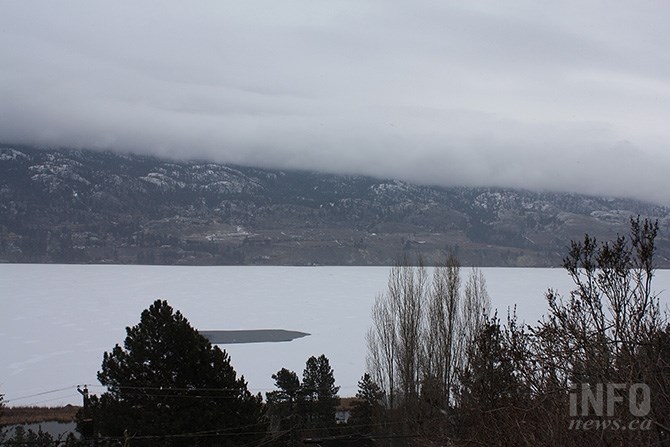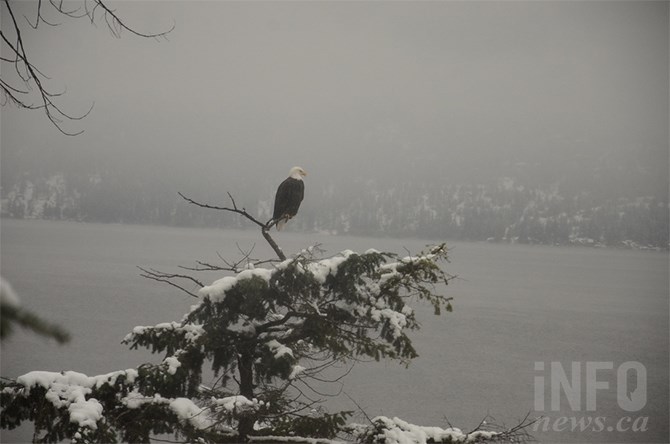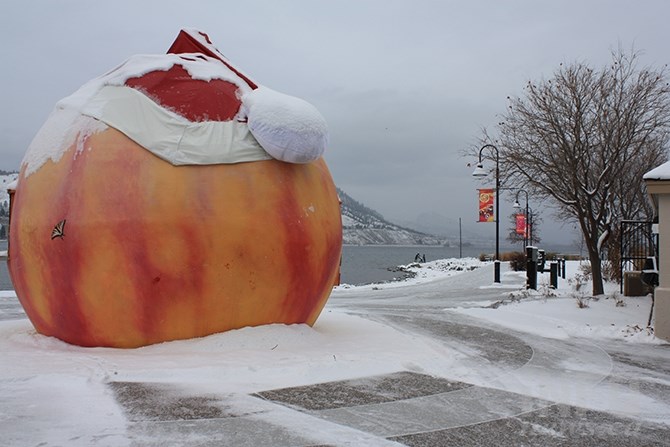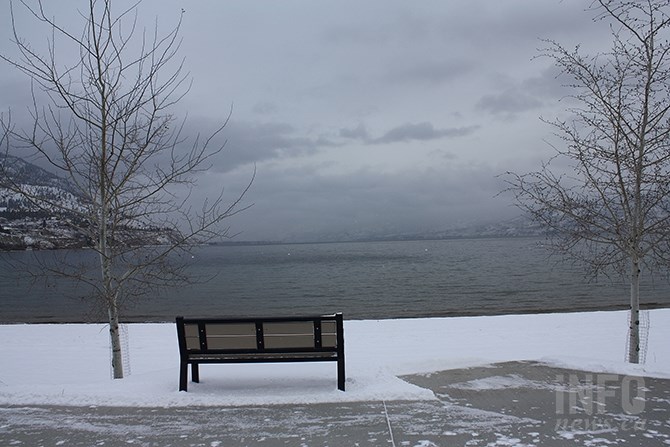
A typical winter scene in the Okanagan with mid-elevation clouds obscuring the sky during a winter inversion.
(STEVE ARSTAD / iNFOnews.ca)
December 09, 2022 - 10:00 AM
If you chose to move to Kamloops or the Okanagan then sunshine, a relative lack of snow compared to other Canadian cities and warmer winters were probably tops on your list and why not? Few places in Canada can beat us on those scores.
But there’s one compromise to living in Kamloops, the Okanagan and much of the Southern Interior. It typically arrives around now and can be unrelenting until spring. At the same time it protects our crops from extremely low temperatures and moderates the bitter cold of winter, it can also ground air traffic, trap pollutants and impact mental health when the sun is blotted out for weeks or months on end.
It’s a weather phenomenon known as a thermal inversion, a thick low-lying cloud cover that hangs over the valleys. They're not unusual around the world, but are particularly stubborn here. While most residents likely have a love-hate relationship, it can be a surprise to our most frequent visitors. Albertans might find relief from freezing temperatures, but they’ll miss the clear skies and sun. Lower Mainlanders and Islanders will escape the constant rain, but not the cloud and lack of daylight.
Simply put, inversions happen when the temperature of the air is cooler at the surface, and there is warmer air above.
That’s not the way it’s supposed to be. Under normal circumstances, air closer to the ground gets warmer because the sun warms the earth’s surface, which then warms the air directly above it. Normally, air temperature decreases with height.

The grey days of an Okanagan winter will soon be upon us.
(BEN BULMER / iNFOnews.ca)
Inversions are predominant under ridges of high pressure, says Environment Canada meteorologist Doug Lundquist.
“If it weren’t for inversions and clouds, we would have much colder nights during fall and winter,” he says.
Lundquist says the valley is under an inversion almost all the time in winter, regardless of the larger weather picture.
They become more frequent and get stronger from fall through winter because of reduced daytime heating, which usually begins in September when the air becomes harder to mix up. Then the conditions that create the inversions reinforce them.
“Cool night air picks up moisture from the lake and produces a fog bank which rises until it meets a stronger and warmer layer of air, held in place by a high pressure ridge,” Lundquist explains.
He says air has to cool a certain amount for every hundred metres to be considered stable, so if it’s not cooling enough with height, that’s actually an inversion.
“The air doesn’t have to warm up with altitude, but it needs to remain stable. The layman’s term is ‘warm air aloft,’ and that will trap colder air below, lock in pollution, and keep sunlight from warming the valley bottom,” Lundquist says.

A dressed up Peach concession stand in Penticton adds some colour to a gloomy winter day in the South Okanagan.
(STEVE ARSTAD / iNFOnews.ca)
Although Okanagan Lake contributes to an inversion’s strength, most of the cause of inversions in British Columbia is due to cold air draining into the valleys with the sun having less power to break it up during fall and winter.
“That’s the biggest contributing factor, even more so than the lake,” he says.
Summertime inversions are rare, Lundquist says, because few of them can make it through a summer day.
“Almost every night we develop one, but during the morning they break as the temperature rises. Wildfire smoke is the exception, as it can reduce the amount of sunshine reaching the ground, creating inversions that can last the entire day. This in turn can trap more smoke,” he says.
The Okanagan valley isn’t an exception when it comes to inversions. Lundquist says the Thompson is also prone to inversions, with the Shuswap and North Okanagan getting more stratus and low cloud early in the season and later in spring due to a lack of airflow and more lake area in the Shuswap. They're not uncommon in many of B.C.'s valley bottoms.
Okanagan Lake does contribute to inversions, making them stronger, Lundquist says.
On the plus side, Lundquist says inversions are responsible for the Okanagan’s moderate winter temperatures.

Dull winter weather makes for an empty park bench along Okanagan Lake.
(STEVE ARSTAD / iNFOnews.ca)
“If it weren’t for inversions, we would have much colder nights during fall and winter. The low cloud has a warming effect during the coldest part of winter,” he says.
The strength of those inversions, particularly from the lake effect, is one of the reasons we have successful tree fruits and vineyards in the Okanagan. Kamloops, for example, hasn’t been as successful with apples and grapes because it can get lower temperatures that have wiped out acreages of fruit in the past.
READ MORE: Why Kamloops doesn't (yet) share the Okanagan's bounty of tree-fruits
Weather statistics might explain it best. In June, July and August, Kamloops and Okanagan cities are all in the top ten in Canada for the most days of sunshine, led by Kamloops with 148.93 hours for second in the country, according to weatherstats.ca (Environment Canada no longer carries this data.). But from November to March, that drops to 110.12 for Kamloops, dropping to 27th place among cities in the country. Penticton, Kelowna and Vernon are ranked between 67th and 71st.
READ MORE: The weather phenomenon that makes our Kamloops, Okanagan paradise
But it's often the opposite result for temperature. Kamloops and Okanagan cities top the country for high temperatures in the summer and remain near the top in winter (once you exclude many coastal locations) — because of the inversions.
It’s not without its negative impacts though and it's worth considering the trade-offs for people considering relocating from Alberta or the coast. Anyone who has tried flying through winter knows the cloud cover can be so thick, planes can’t land in local airports, though none of them keep records on flights delayed or cancelled because of local weather.
That cloud cover can also trap pollutants at ground level and is one of the main reasons for open burning restrictions through the winter.
Central Okanagan Regional District air quality coordinator Nance Mora Castro said in an email a 2015-16 air quality study from November to April noted the Okanagan typically has poor venting conditions in winter due to inversions, moderate winds and low temperatures. The colder weather also encourages wood stove use, which adds to air pollutants which get trapped close to the ground due to inversions. The regional district has tried for years to incentivize woodstove users to find cleaner alternatives, such as pellets or gas.
The study also found meteorological conditions differed throughout the Okanagan, possibly due to microclimates that had an influence on wind speed, creating areas of local air stagnation.
Finally, the cloudy conditions caused by winter inversions in the Okanagan could also contribute to seasonal affective disorder, or SAD, which experts believe is caused by a lack of sunlight.
Joy Serada, a clinical counsellor in Vancouver, says she experiences a greatly increased workload in the fall and winter that seems to correlate with the onset of short days consisting of grey skies and long nights.
“Fall and winter are the busiest times for me. The lack of sunshine, shortened hours of daylight mean less time outside, and more complaints of lower moods, less energy and higher anxiety,” she said in an email.
"I see a strong correlation between the B.C. autumn/winter season and mood state. This year, because of COVID-19, we're heading into the fall season already depleted," she said.
— This story was originally published at 6 p.m., Nov. 1, 2020.
To contact a reporter for this story, email Steve Arstad or call 250-488-3065 or email the editor. You can also submit photos, videos or news tips to tips@infonews.ca and be entered to win a monthly prize draw.
We welcome your comments and opinions on our stories but play nice. We won't censor or delete comments unless they contain off-topic statements or links, unnecessary vulgarity, false facts, spam or obviously fake profiles. If you have any concerns about what you see in comments, email the editor in the link above.
News from © iNFOnews, 2022